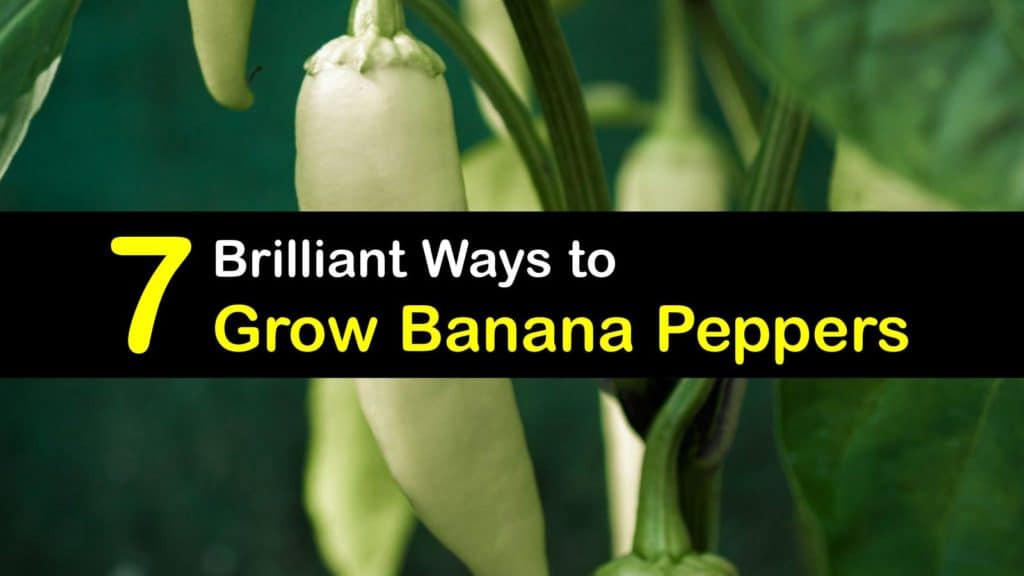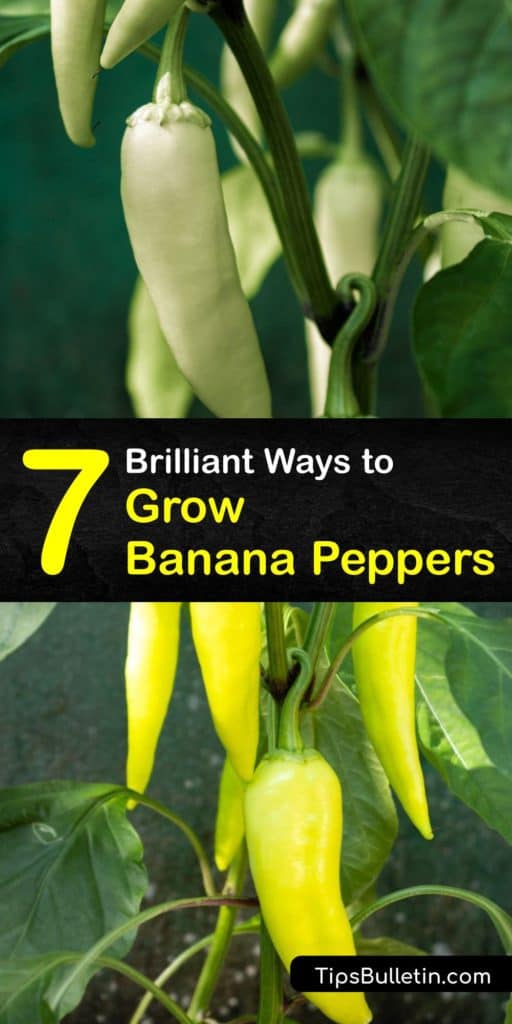Banana peppers, or yellow wax peppers, are chili pepper family members and are sweet, nutritious staples in several dishes. The banana pepper plant is an easy addition to your vegetable garden, and depending on your location, you may harvest your plant more than once. Knowing how to grow banana peppers involves knowing the right conditions for banana pepper plants to thrive.
Banana peppers come in two main types, hot and sweet, and deciding which to grow depends on what you desire for these peppers. Hot banana peppers, sometimes known as Hungarian Wax Peppers, become spicier the longer they remain on the plant and are typically used in salads or pickling.
Sweet peppers generally are eaten fresh or used for stir-fry and sandwiches. When picked, a sweet banana pepper is usually immature with a light yellow color. Sweet peppers, also known as Early Sweet Banana, become sweeter the longer they remain on the plant, though at the cost of their crispness.

Tips for Growing Banana Peppers
Vegetable gardening for banana peppers is simple with the right conditions. Like most pepper varieties, including the poblano peppers growing season, they require warm weather and a long growing season.
While living in a colder climate, your dream to grow banana peppers has to start indoors before you transplant seedlings following your area’s last frost. Once your banana peppers have grown to full size, be sure to store them to last throughout the year. An easy way to store banana peppers is by jarring or canning them to create a mild pickled flavor.
How to Plant Banana Peppers
In the warmest climates, begin by planting your seeds directly into your garden one to two feet apart and in rows that are a minimum of two feet apart. Plant your seeds ¼ inch deep in soil that receives full sun.
If your soil is not at least 60 degrees Fahrenheit, seed starting begins indoors. Seven weeks before the last spring frost, start multiple seeds in a standard four-inch pot and after germination starts, transfer them into individual four-inch pots. Growing green peppers inside starts the same way.
When choosing a container, select one that holds moisture well with good drainage. We recommend glazed terracotta pots as they do not dry out as quickly as an unglazed pot.

The Best Soil Mixture for Growing Banana Peppers
For optimal results, use a potting soil mix that contains perlite and peat moss for your pot-grown banana peppers. While growing, include organic fertilizer according to the product package instructions.
For new seeds, create a mixture to use as your potting soil. Vermiculite works as a soil substitute, prompts root growth, and controls soil moisture. Use a mix that contains perlite and peat moss.
Combine vermiculite, perlite, and peat moss into your four-inch pots to plant your seeds.
Growing Banana Pepper Plants in Containers
Once your banana pepper seeds germinate in their pot and begin to grow, consider adding stakes or a tomato cage to the pot. The addition of a stake or cage supports your plant as it grows while allowing it to receive adequate sunlight.
To keep your growing peppers from weighing down your plant, tie branches with peppers on them to the cage or stake. Water your plant regularly as plants grown in pots lose water faster than plants grown in the ground.
How to Plant Banana Peppers
To transplant pepper seedlings outdoors, wait until two weeks after the last frost ends. To prevent transplant shock, avoid disturbing the roots too much while digging them up and transplanting as much of the plant’s roots as possible.
The rootball should remain moist during transplanting, and watering after planting avoids or minimizes transplant shock. Dig a hole at the same depth and twice the width of the root ball of your plant.
How to Grow Banana Peppers
When wondering how to grow banana peppers from seed, soil temperature and sunlight are essential factors. When planting seeds, whether indoors or outdoors, your seeds need at least eight hours of sunlight per day and for the soil to remain at 60°F.
Keep this in mind when choosing a location for your plant pots inside and for your garden bed location outside. Aside from proper soil temperatures, banana pepper plants require the right nutrients to thrive. If your soil is high in potassium, it causes a magnesium deficiency in your plant.
Magnesium deficiency shows in your plants in the form of yellowing between leaf veins and reddish-brown tints on leaves, as well as early leaf fall. To resolve the deficit, add Epsom salts to the soil around your plant.
Adding mulch around your outdoor plant keeps weeds at bay and helps maintain proper moisture.
How to Harvest Banana Peppers
When fully mature banana peppers ripen, they grow to four to eight inches and begin to curve; they are ready for harvest. Maturity happens roughly 70 days after transplanting.
The color of your banana peppers may vary by cultivar, but typically banana peppers are pale yellow. When harvesting, peppers may be slightly orange or red around the tips – this is normal.
Avoid pulling on your pepper when you pick banana peppers, which could damage the plant. Sever the fruit from the plant with garden shears or a sharp knife.
After picking your peppers, store them short-term in the fridge. How long do banana peppers last? Keep your peppers for about a week this way.
Common Pests for Banana Pepper Plants
Banana peppers are vulnerable to common pests like aphids, cutworms, and flea beetles, among others. While some pests are big enough to pluck off your leaves, deal with smaller harmful insects by spraying your plant with horticultural soap or applying a homemade insecticide.
Diluting rubbing alcohol kills pests while not damaging your plant, and dish soap coats the spray to the leaves for prolonged use.
Combine the ingredients in your spray bottle and spritz your plant’s leaves to kill pests and prevent more from gathering.
Avoiding Disease on Your Banana Pepper Plants
Like similar pepper plants such as jalapeno or bell peppers, your banana pepper plant is vulnerable to disease as well as pest infestation. Keeping insects away is one method to avoid illness, as many insects are vectors for diseases.
Practicing smart watering techniques is another way to avoid mold growing on your plants. Don’t overwater and only water the base of your plant, not the leaves directly.
Sowing high-quality seeds, like heirloom seeds, and using disease-free soil also help avoid problems with your plant.
What is Blossom End Rot?
Blossom end rot is a disorder caused by factors in your plant’s environment instead of an infected disease. A deficiency in calcium leads to blossom end rot. Changes or stress in soil moisture cause calcium deficiency. Soil stress comes from wet weather at the start of the growing season, followed by high temperatures.
An increase in nitrogen in the soil may also contribute to a lack of calcium. After adding fertilizer to enhance plant growth, the plant may not gather enough calcium in the soil to keep up with its development.
The rot occurs when the base of your fruit, where it meets the stem, fills with water. It’s easy to tell if banana peppers are bad if they have blossom end rot.
Over time this area turns brown and rots away. Experiencing this at the beginning of the season is normal and resolved by removing the affected fruit; however, consistent rot ruins your entire crop.
Growing banana peppers in your home garden is a rewarding way to bring fresh veggies to the table, whether you prefer sweeter peppers or hot varieties. We hope you found our tips on how to plant banana peppers helpful.

Knowing how to grow banana peppers ensures you take the best care of your plant on its way to harvest, so please share our gardening tips on growing banana peppers on Facebook and Pinterest with your family and friends.